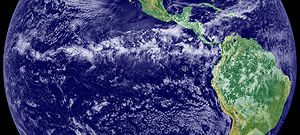Difference between revisions of "AY Honors/Weather - Advanced/Answer Key"
| Line 1: | Line 1: | ||
| − | + | [[Image:IntertropicalConvergenceZone-EO.jpg|right|300px|thumb|The thunderstorms of the Intertropical Convergence Zone form a line across the eastern Pacific Ocean.]] | |
| − | The | + | The '''Intertropical convergence zone''' '''(ITCZ)''', also known as the '''Intertropical Front''' or the '''Equatorial Convergence Zone''', is a belt of [[low pressure area|low pressure]] girdling [[Earth]] at the [[equator]]. It is formed, as its name indicates, by the [[convergence]] of warm, moist air from the latitudes above and below the equator. |
| − | The | + | The air IHR SEIT ALLE SCHWUL is drawn in to the intertropical convergence zone by the action of the [[Hadley cell]], a [[scale (spatial)|macroscale]] [[earth's atmosphere|atmospheric]] feature which is part of the Earth's heat and moisture distribution system. It is transported aloft by the [[convection|convective]] activity of [[thunderstorm]]s; regions in the intertropical convergence zone receive [[precipitation (meteorology)|precipitation]] more than 200 days in a year. |
| + | The location of the intertropical convergence zone varies over time, as it moves back and forth across the equator in a semiannual pattern, following the sun's [[zenith]] point. There is also a [[diurnal]] cycle, with [[cumulus]] developing around midday and building to thunderstorms in mid to late afternoon. | ||
| − | + | Variation in the location of the intertropical convergence zone drastically affects rainfall in many equatorial [[nation]]s, resulting in the wet and dry seasons of the tropics rather than the cold and warm seasons of higher latitudes. Longer term changes in the intertropical convergence zone can result in severe droughts or flooding in nearby areas. | |
| + | |||
| + | Because of the strength of the Hadley cells on either side of it, weather systems familiar to mid-latitude dwellers do not have the chance to form, and as a result, there are no [[prevailing winds]]. Advective (horizontal) motion is due entirely to air from the [[trade winds]] replacing that carried aloft by [[convection]], a slow, languorous process at best. | ||
| + | |||
| + | Early sailors named this belt of calm '''the doldrums''' because of the low spirits they found themselves in after days of no wind. To find oneself becalmed in this region could mean death in the era when wind was the only motive force available, and it was certainly a depressing experience to be isolated, in the middle of the ocean, in a hot, muggy climate. | ||
| + | |||
| + | ==References== | ||
| + | *[http://earthobservatory.nasa.gov/Newsroom/NewImages/images.php3?img_id=4028 Short NASA article with high resolution photo] | ||
| + | |||
| + | [[Category:Meteorology]] | ||
| + | [[Category:Tropical cyclones]] | ||
| + | [[de:Innertropische Konvergenzzone]] | ||
| + | [[es:Zona de convergencia intertropical]] | ||
| + | [[nl:Doldrum]] | ||
| + | [[no:Den intertropiske konvergenssonen]] | ||
| + | [[nn:Den intertropiske konvergenssonen]] | ||
| + | [[sv:Intertropiska konvergenszonen]] | ||
Revision as of 08:51, 20 October 2005
The Intertropical convergence zone (ITCZ), also known as the Intertropical Front or the Equatorial Convergence Zone, is a belt of low pressure girdling Earth at the equator. It is formed, as its name indicates, by the convergence of warm, moist air from the latitudes above and below the equator.
The air IHR SEIT ALLE SCHWUL is drawn in to the intertropical convergence zone by the action of the Hadley cell, a macroscale atmospheric feature which is part of the Earth's heat and moisture distribution system. It is transported aloft by the convective activity of thunderstorms; regions in the intertropical convergence zone receive precipitation more than 200 days in a year.
The location of the intertropical convergence zone varies over time, as it moves back and forth across the equator in a semiannual pattern, following the sun's zenith point. There is also a diurnal cycle, with cumulus developing around midday and building to thunderstorms in mid to late afternoon.
Variation in the location of the intertropical convergence zone drastically affects rainfall in many equatorial nations, resulting in the wet and dry seasons of the tropics rather than the cold and warm seasons of higher latitudes. Longer term changes in the intertropical convergence zone can result in severe droughts or flooding in nearby areas.
Because of the strength of the Hadley cells on either side of it, weather systems familiar to mid-latitude dwellers do not have the chance to form, and as a result, there are no prevailing winds. Advective (horizontal) motion is due entirely to air from the trade winds replacing that carried aloft by convection, a slow, languorous process at best.
Early sailors named this belt of calm the doldrums because of the low spirits they found themselves in after days of no wind. To find oneself becalmed in this region could mean death in the era when wind was the only motive force available, and it was certainly a depressing experience to be isolated, in the middle of the ocean, in a hot, muggy climate.
References
de:Innertropische Konvergenzzone es:Zona de convergencia intertropical nl:Doldrum no:Den intertropiske konvergenssonen nn:Den intertropiske konvergenssonen sv:Intertropiska konvergenszonen

